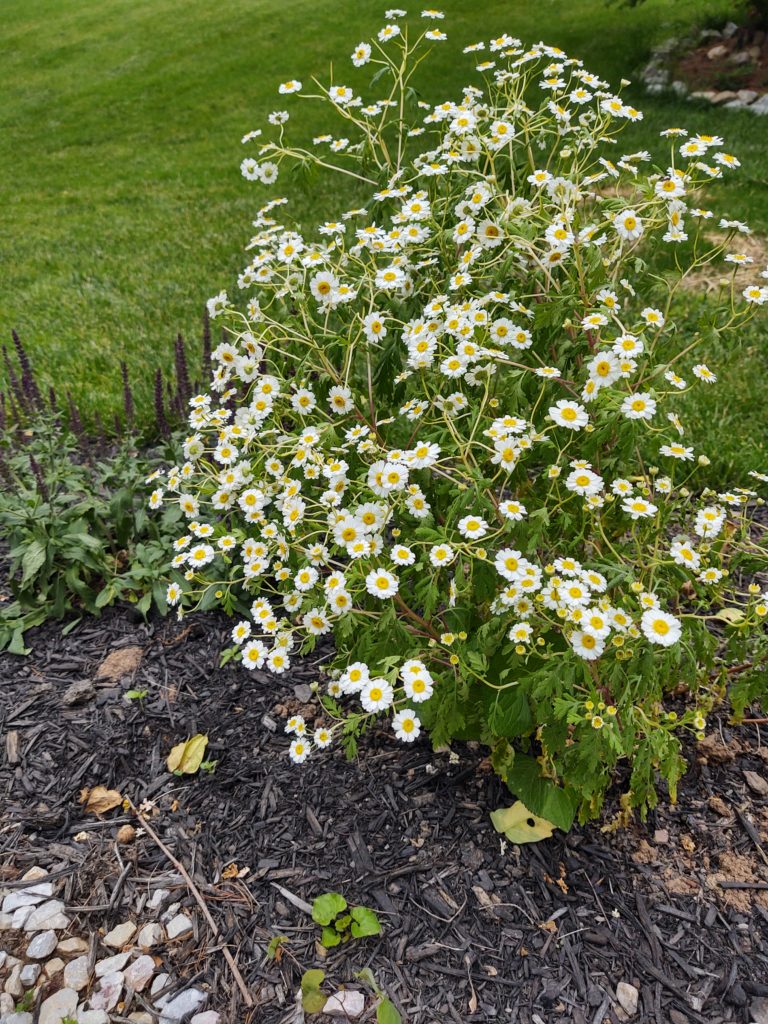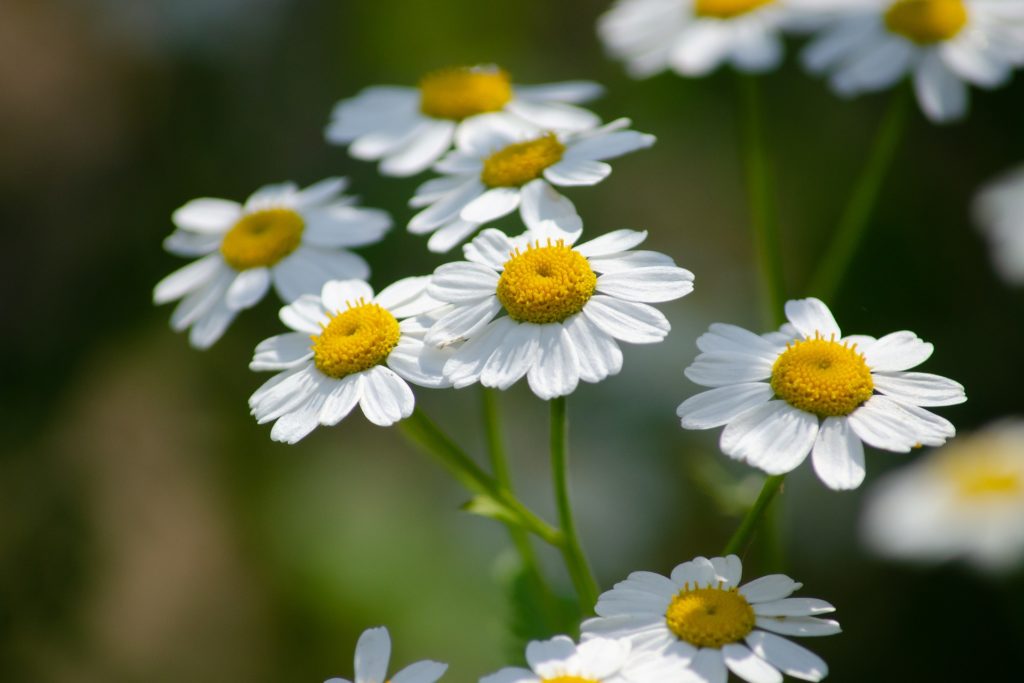Feverfew (tanaceum parthenium)
Although there has been extensive research about the benefits of feverfew for migraines, I thought I’d share my own – real world – observations.

Feverfew is a gorgeous little shrub that is closely related to chamomile and tansy. It can grow to about 3 feet in height and readily reseeds. It is a perennial and features a white daisy-like flower with what seems (to me) a popped-out sort of rounded button center.

Nicolas Culpeper once touted feverfew as a women’s herb, saying that it is a great strengthener of the womb., Culpeper wrote The English Physitian – also known as Culpeper’s Complete Herbal – in 1652, and much more is known about this herb now.
Feverfew is mainly known for its headache reducing and migraine prevention properties. Taken daily it can lessen the frequency of migraines, as well as taken at the first sign of the migraine can help to stop it. For tension headaches I have found a tea/infusion made of feverfew with chamomile to be very useful. Tincture:10-15 drops daily for long-term prevention; Tincture: 5-10 drops with chamomile tincture (20 drops) is my go-to for headaches and for when a migraine hits. For an infusion: 1 part dried chamomile, ½ part dried feverfew, infuse (steep) with freshly boiled water, and cover the mug, for 10-15 minutes. Sweeten with honey, or sugar or stevia as desired. Drink up to three times daily for tension headaches.
An infusion of feverfew with willow bark may help reduce fevers and you can use feverfew in conjunction with St. Johns wort and comfrey in an infusion to help ease inflamed joints.
Creating a tincture using the folk method is extremely easy but I think the following article is highly beneficial. This is from The Herbal Academy: (https://theherbalacademy.com/how-to-make-a-tincture/)
Cautions: Avoid feverfew if you are taking blood thinners, or if you are pregnant. Use caution when eating fresh leaves as they have been known to cause mouth sores.
How to Make a Tincture
1. Remove the fresh or dried herbs off of the stalks. If using freshly dug roots, wash and scrub them of dirt.
2. Chop fresh herbs and grind dried herbs to increase the surface area for the maceration. Place herbs into a clean, dry jar with a wide mouth.
3. Pour high proof alcohol (vodka or brandy) over the herbs until the alcohol level is an inch above the top of the herbs. Dry herbs may absorb the liquid, so check and add alcohol as needed.
4. Cover tightly with a lid and place the jar in a dark cupboard and allow to soak or macerate for 4-6 weeks.
5. During this time period, give the jar a shake every 2-3 days. Keep an eye on the alcohol level to ensure all your herbs are still covered.
6. Once macerating is complete, layer cheesecloth a few times over top of a clean bowl and secure with rubber band if possible.
7. Strain the mixture through the cheesecloth and with clean hands, gather the cloth up and squeeze strongly so every bit of possible liquid is drained from the herbs.
8. Allow material to settle overnight and strain again, or decant, through a smaller filter such as filter paper or a thin wire screen.
9. Use a funnel to transfer into labeled, amber bottles and store out of the light.
An alcohol based tincture will last many years. Using a standard sized dropper bottle, adult dosages are typically 30 to 60 drops in a little water, taken three times a day. However, drop size can be variable depending on the viscosity of the preparation and the dropper size, so if you prefer more precision in your dosage you can consult a reputable publication like Medical Herbalism by David Hoffman.
Learning how to make a tincture is just one of the first things beginners learn in herbalism. If you are interested in studying herbalism, start your journey in the Online Introductory Herbal Course or the Online Intermediate Herbal Course. Learn more about herbs and how to use them as medicine and as food!
REFERENCES
Cech, Richo. (2000) Making Plant Medicine. Williams, OR: Horizon Herbs
Gladstar, Rosemary. (2012) Medicinal Herbs: A Beginners Guide. North Adams, MA: Storey Publishing.
Herbal Academy of New England. (2013) Herbal First Aid, Herbal Academy of New England’s Medicine Making Handbook

Kathy is an herbalist/naturopathic practitioner who is constantly researching to expand her knowledge. She came to herbalism after her migraine medicine was suddenly removed from the market and she had to find something new. After discovering the magic of herbs she’s never looked back. She is accredited by the International Practitioners of Holistic Medicine (IPHM) and is an Associate Member of the American Herbalist Guild.